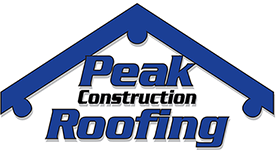After a storm, it’s crucial to perform a thorough inspection of your roof to assess and mitigate any potential damage. In this guide, Peak Construction Roofing walks you through the essential steps of conducting a roof inspection after a storm to ensure your home remains protected.

Prioritize Safety First
The aftermath of a storm can pose numerous safety hazards, from downed electrical lines to structural damage. Before inspecting your roof for visible signs of potential danger, ensure you do so safely—or better yet, contact a professional immediately. Many reputable experts specialize in post-storm inspections and repairs, equipped with the tools and expertise to assess your property safely and effectively.
Inspect Visually From the Ground
Start your inspection by taking a walk around your home. From the ground, you can spot several indicators of roof damage such as missing shingles, dents on metal roofs, or debris that may have impacted your roof’s surface. Use a pair of binoculars for a closer look if needed. Documenting these initial findings can be very helpful, especially when filing insurance claims or discussing the scope of work with a roofer.
Check Gutters, Downspouts and Flashing
The storm’s impact isn’t limited to the roof surface. Check your gutters and downspouts for any signs of detachment, clogging or damage. Efficient water diversion systems are crucial for your home’s integrity, preventing foundation and structural issues. Likewise, inspect the flashing around chimneys, vents and along the roof’s edges. Damage here can lead to leaks, causing further problems to your home’s interior.
Look for Internal Signs of Leaks
After inspecting the exterior, it’s important to check your home’s interior for water damage. Ceilings and walls may display water stains or signs of mold, indicating potential leaks. Your attic should also be inspected for dampness or water penetration. Early detection of these issues can prevent more significant problems down the line.
Document Everything
While conducting your inspection, take detailed notes and photographs of all findings. This documentation will be invaluable when you contact your insurance company or a professional roofing contractor for repairs. Timely and detailed reporting can expedite the claims process and ensure you receive the support you need to restore your roof’s integrity.
Consult a Professional Roofing Team
After a storm, it’s advisable to have a professional roofing contractor conduct a more thorough inspection. They can identify subtler signs of damage that you might overlook and recommend the best course of action, whether it’s repairs or a full replacement.
Review Your Insurance Policy
Reach out to your insurance provider to understand your coverage and start the claims process if necessary. Knowing your policy details can make a significant difference in how you approach the repair or replacement of your storm-damaged roof.
Inspecting your roof after a storm is crucial in maintaining the safety and integrity of your home. At Peak Construction Roofing, our team is ready to deliver roofing services tailored to your needs following any storm. Call us at (218) 728-8033 (Duluth, MN), (218) 749-0859 (Virginia, MN) or (715) 699-1167 (Hayward, WI) for professional roofing advice. You can also fill out our contact form to schedule an appointment.
